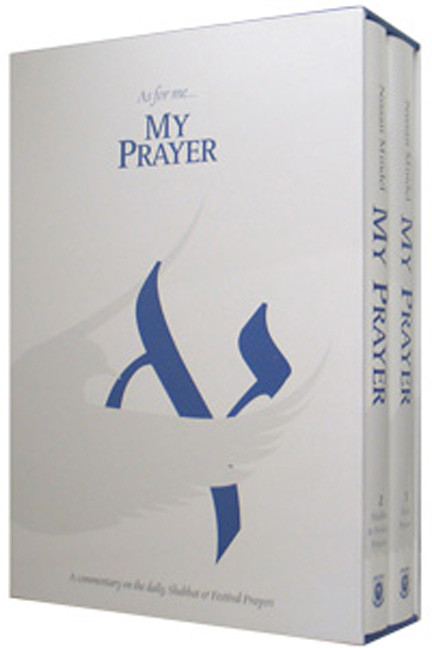You really DO have a prayer. Read about it — and use it!
Among the classic writings concerning Jewish liturgy are two works from Chabad — an English translation of their prayer book, “Siddur Tehillat Hashem,” by Rabbi Nissen Mangel, and the classic detailed commentary and exposition of Jewish liturgy by Rabbi Dr. Nissan Mindel, zt”l, entitled, “My Prayer,” first published in 1972 and recently reissued by Kehot in a two volume revised edition.
“My Prayer,” reflecting scholarship drawn from the works of Maimonides and Chasidic masters, presents a deeper meaning of the prayers and a comprehensive understanding of the moral and ethical teachings contained therein. The singular example below should serve as a sample of the late Rabbi Mindel’s teachings.
One of the basic features of Jewish liturgy is the vast amount of Biblical writings that are contained throughout. Next week’s Torah reading, Parashat Balak, contains a verse that, for most siddurim, serves as the opening prayer for the everyday morning service. This verse is found in Bemidbar 24:5:
“How goodly are your tents, O Jacob, your dwelling places, O Israel!”
Perhaps no one said it better than Dr. Ellen Frankel, when she noted the paradox of, “How peculiar that we Jews begin our morning prayers by reciting the blessing forced from the mouth of the pagan prophet Balaam by Divine fiat!”
This liturgical irony is further explicated by many others who see in it the benchmark of the uniqueness of our faith in its ability to encompass the negativity of those who wish to curse and harm us, and turn that sentiment to blessing.
Rabbi Mindel’s commentary parses the various phrases that inhabit this liturgical paragraph and webs together a beautiful word picture of the underlying meaning to the overall text.
The accompanying text, as per the nusach (prayer version) used by Rabbi Mindel, Nusach Ari, consists of a total of three Biblical verses. The first was referenced above, the second is from Psalms 5:8, “As for me, through your abundant kindness I will come into Your house; I will bow toward Your Sanctuary, in awe of You.” The third is from Psalms 69:14, “As for me, may my prayer to You, L-rd, be in a time of grace; O G-d, in Your abounding kindness, answer me with Your true deliverance.”
In explicating these phrases into a complete commentary, Rabbi Mindel analyzes the key words that he contends, spiritually carry the liturgical message.
First, he takes note of “tents,” viewing them as “tents of Torah,” where the Torah is studied.
Next there is “Dwelling places” which he interprets as referring to Mishkan and Mikdash, and by historical extension, the synagogue.
Further on, he extends the synagogue metaphor in the application of Jewish worship to the atmosphere of the synagogue ambiance, especially at the beginning of the day.
“Looking further into this short prayer of Mah Tovu, consisting of three verses, and being an ‘introduction’ to the morning prayers, we can see that each verse stresses a different thing: The first verse stresses the ‘tents’ and ‘sanctuaries’; the second stresses our feelings when we enter the synagogue; the third stresses the auspiciousness of the time of prayer.”
When one considers the pagan origins of the one who uttered the initial verse, one must pause to consider the foundational importance that words have when read and assimilated with depth and concentration. The interpretations by Rabbi Mindel are but a harbinger of what the rest of his teachings on the siddur contained in these two volumes have come to mean to the past three to four generations of English speaking Jews around the world.
Rabbi Mindel comes to these teachings fully equipped with the scholarship needed for the broad range of interpretations utilized in his analysis of the prayer texts. Just consider his educational background; he earned a B.A. and M.A. in political science at the University of Manchester and received his Ph.D. in Semitic Languages from Columbia University. He was, throughout his life, a prolific author, a translator who served on the editorial board of the Kehot Publishing Society and the Chabad Research Center until his passing in 1999. Make “My Prayer” your prayer, and your davening will most surely benefit from Rabbi Mindel’s Torah.
FOR FURTHER STUDY
For those who read and study each week’s Onkelos Targum, a careful reading of Bamidbar 24:5, will note that the Mah Tovu phrase in its Aramaic incarnation will show a radical change in meaning for the Hebrew word “Ohalecha,” tents. The Aramaic text says, “Ar’ach,” land !
According to Rabbi Israel Drazin’s commentary on this verse, we learn the following ‘chidush’: that Onkelos changes the plural of tents to the singular, land, thus, “focusing on Canaan, the land toward which the people are advancing. Compare Jeremiah 30:18 where ‘tent’ is also rendered ‘land’ by the Targum.”
Rabbi Drazin, in his commentary, makes further reference to the Talmud and other Targumim for other related changes and interpretations such as referring to tents as houses of study and not residences.[“Onkelos on the Torah: Numbers,” Rabbi Israel Drazin and Rabbi Stanley Wagner, Gefen Publishing, 2011, page 227].
I wish to conclude with the following beautiful teaching from Dr. Israel Rubin’s “The How & Why of Jewish Prayer,” page 231:
“You would not normally barge into a king’s chamber. Similarly when you enter G-d’s sanctuary, you should pause to ‘request permission’ to enter. This is done by pausing at the entrance door and recite Mah Tovu. Once inside, wait and pause a little and then recite Ps. 5:8. Only then proceed to your fixed place of worship. Regrettably, this very beautiful custom has fallen into disuse. It should be revived.”

 61.0°,
Mostly Cloudy
61.0°,
Mostly Cloudy 







